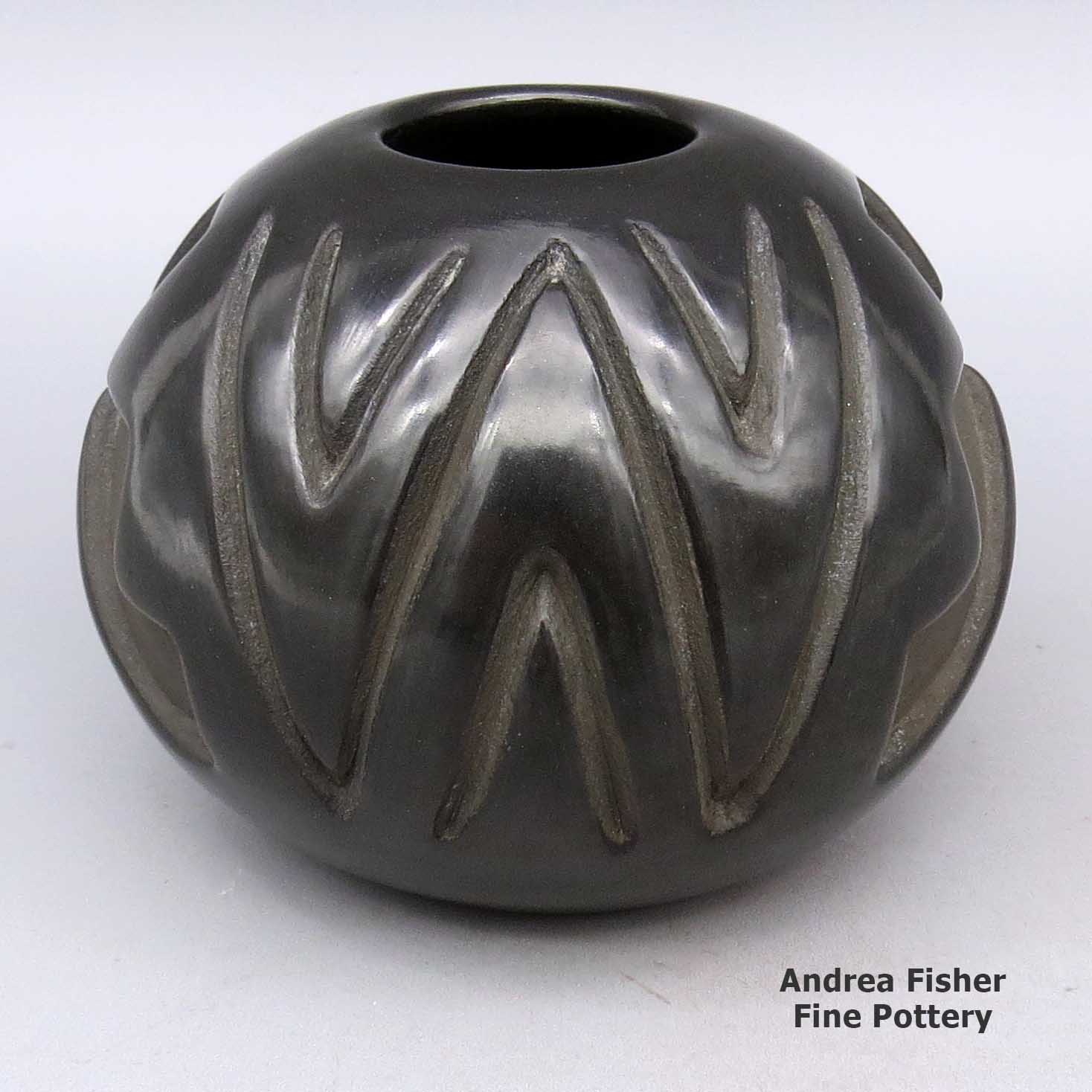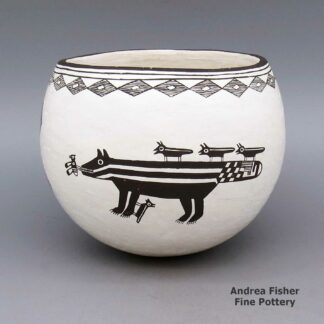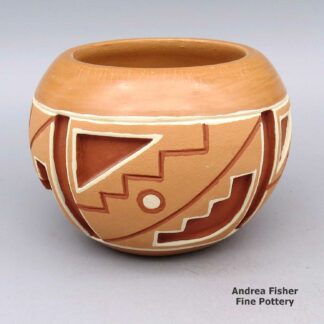| Dimensions | 4.5 × 4.5 × 3.5 in |
|---|---|
| Condition of Piece | Very good, normal wear |
| Signature | Anita L. Suazo Santa Clara Pueblo |
Anita Suazo, plsc2l118, Black bowl with carved geometric design
$525.00
A black bowl carved with a geometric design
In stock
Brand
Suazo, Anita
Often collaborating with her husband, Joseph Suazo, Anita made blackware and redware, polychrome redware, two-tone black on black carved pottery and black melon pots. She liked to carve some pots and paint others with avanyu, kiva step, cloud, feather and other designs passed down for a thousand years and more.
Anita first entered a piece in the juried competitions of the Santa Fe Indian Market in 1979. After that she was consistently earning ribbons for years at the Santa Fe Indian Market, the Eight Northern Indian Pueblo Arts & Crafts Show and the New Mexico State Fair.
Anita was a participant, along with Margaret Tafoya and 42 other Santa Clara Pueblo potters, in a 1985 show at the Sid Deusch Gallery in New York. In 1986 she earned the Jack Hoover Memorial Award for excellence in Santa Clara pottery.
Pieces of her work can be seen at the Smithsonian Museum in Washington DC, the Heard Museum in Phoenix, the Millicent Rogers Museum in Taos and the Museum of New Mexico in Santa Fe.
Anita has taught pottery classes at the University of California at Davis and at the University of New Mexico.
Some of the Awards Anita earned
- 2011 Heard Museum Guild Indian Fair & Market. Class II - Pottery, Div. C - Traditional, native clay, hand built, carved, Honorable Mention
- 2004 Santa Fe Indian Market. Class II - Pottery, Div. C - Traditional pottery, carved or incised, Cat. 1001 - Jars, Third Place
- Cat. 1002 - Wedding jars, Second Place - 2000 Santa Fe Indian Market. Class. II - Pottery, Div. C - Traditional pottery, carved or incised, Cat. 1004 - Bowls (over 7" in diameter), Second Place
- 1997 Santa Fe Indian Market. Class II - Pottery, Div. B - Traditional pottery, undecorated, Cat. 903 - Melon bowls, Third Place
- 1995 Santa Fe Indian Market. Class. II - Pottery, Div. B - Traditional pottery, undecorated, Cat. 902 - Jars (over 9 inches tall), Third Place
- Div. D - Traditional pottery, carved, Cat. 1101 - Jars (up to 7 inches tall), Second Place - 1993 Santa Fe Indian Market. Class II - Pottery, Div. E - Traditional pottery, undecorated, Cat. 903 - Melon bowls and jars, black, Second Place
- 1992 Santa Fe Indian Market. Class II - Pottery, Div. B - Traditional pottery, undecorated, Cat. 905 - Other bowls, First Place
- Div. E - Traditional pottery, painted designs on burnished black or red surface, Cat. 1206 - Figures, Third Place - 1991 Santa Fe Indian Market. Class II - Pottery, Div. B - Traditional pottery, undecorated, Cat. 901 - Jars (to 8 inches), Third Place
- 1990 Santa Fe Indian Market. Class. II - Pottery, Div. E - Traditional pottery, painted designs on burnished black or red surface, Cat. 1104 - Bowls (over 8 inches in diameter), Third Place
- 1989 Santa Fe Indian Market. Class II - Pottery, Div. B - Traditional pottery, undecorated, Cat. 803 - Melon bowls, black, Third Place
- Cat. 805, other bowls, Second Place - 1988 Gallup InterTribal Ceremonial. Class IV - Pottery, Cat. 10, Jar, seed jar, canteen, Second Place
- 1986 Santa Fe Indian Market. Jack Hoover Memorial Award for Excellence in Santa Clara Pottery
- Class II - Pottery, Div. B - Traditional pottery, undecorated, Cat. 803 - Melon bowls, Second Place
- 1984 Santa Fe Indian Market. Class II - Pottery, Div. E - Traditional pottery, painted designs on burnished black or red surface, Cat. 1101 - Jars (up to 8 inches tall), Third Place
- 1983 Santa Fe Indian Market. Class II - Pottery, Div. D - Traditional, carved, Third Place
A Short History of Santa Clara Pueblo

Santa Clara Pueblo straddles the Rio Grande about 25 miles north of Santa Fe. Of all the pueblos, Santa Clara has the largest number of potters.
The ancestral roots of the Santa Clara people have been traced to ancient pueblos in the Mesa Verde region in southwestern Colorado. When the weather in that area began to get dry between about 1100 and 1300 CE, some of the people migrated to the Chama River Valley and constructed Poshuouinge (about 3 miles south of what is now Abiquiu on the edge of the mesa above the Chama River). Eventually reaching two and three stories high with up to 700 rooms on the ground floor, Poshuouinge was inhabited from about 1375 CE to about 1475 CE.
Drought then again forced the people to move. One group of the people went to the area of Puyé (along Santa Clara Canyon, cut into the eastern slopes of the Pajarito Plateau of the Jemez Mountains). Another group went south of there to what we now call Tsankawi. A third group went a bit to the north, following the Rio Chama down to where it met the Rio Grande and founded Ohkay Owingeh on the northwest side of that confluence.
Beginning around 1580, another drought forced the residents of the Puyé area to relocate closer to the Rio Grande. There, near the point where Santa Clara Creek merged into the Rio Grande, they founded what we now know as Santa Clara Pueblo. Ohkay Owingeh was to the north on the other side of the Rio Chama. That same dry spell forced the people down the hill from Tsankawi to the Rio Grande where they founded San Ildefonso Pueblo to the south of Santa Clara, on the other side of Black Mesa.
In 1598 Spanish colonists from nearby Yunqué (the seat of Spanish government near the renamed "San Juan de los Caballeros" Pueblo) brought the first missionaries to Santa Clara. That led to the first mission church being built around 1622. However, the Santa Clarans chafed under the weight of Spanish rule like the other pueblos did and were in the forefront of the Pueblo Revolt of 1680. One pueblo resident, a mixed black and Tewa man named Domingo Naranjo, was one of the rebellion's ringleaders.
When Don Diego de Vargas came back to the area in 1694, he found most of the Santa Clarans were set up on top of nearby Black Mesa (with the people of San Ildefonso, Pojoaque, Tesuque and Nambé). An extended siege didn't subdue them but eventually, the two sides negotiated a treaty and the people returned to their pueblos. However, successive invasions and occupations by northern Europeans took their toll on the pueblos over the next 250 years. The Spanish flu pandemic in 1918 almost wiped them out.
Today, Santa Clara Pueblo is home to as many as 2,600 people and they comprise probably the largest per capita number of artists of any North American tribe (estimates of the number of potters run as high as 1-in-4 residents).
For more info:Pueblos of the Rio Grande, Daniel Gibson, ISBN-13:978-1-887896-26-9, Rio Nuevo Publishers, 2001
Upper photo courtesy of Einar Kvaran, Creative Commons Attribution-Share Alike 3.0 Unported License
About Bowls
The bowl is a basic utilitarian shape, a round container more wide than deep with a rim that is easy to pour or sip from without spilling the contents. A jar, on the other hand, tends to be more tall and less wide with a smaller opening. That makes the jar better for cooking or storage than for eating from. Among the Ancestral Puebloans both shapes were among their most common forms of pottery.
Most folks ate their meals as a broth with beans, squash, corn, whatever else might be in season and whatever meat was available. The whole village (or maybe just the family) might cook in common in a large ceramic jar, then serve the people in their individual bowls.
Bowls were such a central part of life back then that the people of the Classic Mimbres society even buried their dead with their individual bowls placed over their faces, with a "kill hole" in the bottom to let the spirit escape. Those bowls were almost always decorated on the interior (mostly black-on-white, color came into use a couple generations before the collapse of their society and abandonment of the area). They were seldom decorated on the exterior.
It has been conjectured that when the great migrations of the 11th, 12th, 13th and 14th centuries were happening, old societal structures had to change and communal feasting grew as a means to meet, greet, mingle with and merge newly arrived immigrants into an already established village. That process called for larger cooking vessels, larger serving vessels and larger eating bowls. It also brought about a convergence of techniques, styles, decorations and design palettes as the people in each locality adapted. Or didn't: the people in the Gallina Highlands were notorious for their refusal to adapt and modernize for several hundred years. They even enforced a No Man's Land between their territory and that of the Great Houses of Chaco Canyon, killing any and all foreign intruders. Eventually, they seem to have merged with the Towa as those people migrated from the Four Corners area to the southern Jemez Mountains.
Traditional bowls lost that societal importance when mass-produced cookware and dishware appeared. But, like most other Native American pottery in the last 150 years, market forces caused them to morph into artwork.
Bowls also have other uses. The Zias and the Santo Domingos are known for their large dough bowls, serving bowls, hair-washing bowls and smaller chili bowls. Historically, these utilitarian bowls have been decorated on their exteriors. More recently, they've been getting decorated on the interior, too.
The bowl has also morphed into other forms, like Marilyn Ray's Friendship Bowls with children, puppies, birds, lizards and turtles playing on and in them. Or Betty Manygoats' bowls encrusted with appliqués of horned toads or Reynaldo Quezada's large, glossy black corrugated bowls with custom ceramic black stands.
When it comes to low-shouldered but wide circumference ceramic pieces (such as many Sikyátki-Revival and Hawikuh-Revival pieces are), are those jars or bowls? Conjecture is that the shape allows two hands to hold the piece securely by the solid body while tipping it up to sip or eat from the narrower opening. That narrower opening, though, is what makes it a jar. The decorations on it indicate that it is more likely a serving vessel than a cooking vessel.
This is where our hindsight gets fuzzy. In the days of Sikyátki, those potters used lignite coal to fire their pieces. That coal made a hotter fire than wood or manure (which wasn't available until the Spanish brought it). That hotter fire required different formulations of temper-to-clay and mineral paints. Those pieces were perhaps more solid and liquid resistant than most modern Hopi pottery is: many Sikyátki pieces survived intact after being slowly buried in the sand and exposed to the desert elements for hundreds of years. Many others were broken but were relatively easy to reassemble as their constituent pieces were found all in one spot and they survived the elements. Today's pottery, made the traditional way, wouldn't survive like that. But that ancient pottery might have been solid enough to be used for cooking purposes, back in the day.
About Geometric Designs
"Geometric design" is a catch-all term. Yes, we use it to denote some kind of geometric design but that can include everything from symbols, icons and designs from ancient rock art to lace and calico patterns imported by early European pioneers to geometric patterns from digital computer art. In some pueblos, the symbols and patterns denoting mountains, forest, wildlife, birds and other elements sometimes look more like computer art that has little-to-no resemblance to what we have been told they symbolize. Some are built-up layers of patterns, too, each with its own meaning.
"Checkerboard" is a geometric design but a simple black-and-white checkerboard can be interpreted as clouds or stars in the sky, a stormy night, falling rain or snow, corn in the field, kernels of corn on the cob and a host of other things. It all depends on the context it is used in, and it can have several meanings in that context at the same time. Depending on how the colored squares are filled in, various basket weave patterns can easily be made, too.
"Cuadrillos" is a term from Mata Ortiz. It denotes a checkerboard-like design using tiny squares filled in with paints to construct larger patterns.
"Kiva step" is a stepped geometric design pattern denoting a path into the spiritual dimension of the kiva. "Spiral mesa" is a similar pattern, although easily interpreted with other meanings, too. The Dineh have a similar "cloud terrace" pattern.
That said, "geometric designs" proliferated on Puebloan pottery after the Spanish, Mexican and American settlers arrived with their European-made (or influenced) fabrics and ceramics. The newcomers' dinner dishes and printed fabrics contributed much material to the pueblo potters design palette, so much and for so long that many of those imported designs and patterns are considered "traditional" now.
Belen Tapia Family Tree - Santa Clara Pueblo
Disclaimer: This "family tree" is a best effort on our part to determine who the potters are in this family and arrange them in a generational order. The general information available is questionable so we have tried to show each of these diagrams to living members of each family to get their input and approval, too. This diagram is subject to change should we get better info.
- Belen Tapia & Ernest Tapia
- Leonard Tapia & Romancita Gutierrez
- Anita L. Suazo & Joseph Suazo
- Gayle Leyva & Phil Leyva
- Angel Suazo-Peter (1955-2011) & Dean Peter
- Leonard Suazo
- Jason White Eagle Suazo & Lahoma Suazo
- Joseph Suazo Jr.
- Paul Tapia
- Frank Tapia & Mae Tapia (1952-2015)
- April Tapia & Joseph Gutierrez
- Ira Tapia & Morena Tapia
- Bennie Tapia & Gail Gutierrez
- Anna Archuleta & Fidel Archuleta









